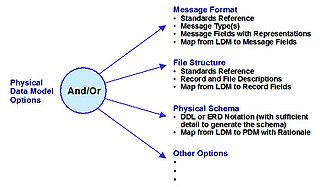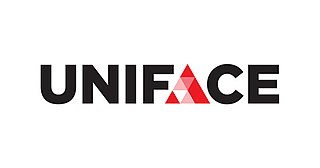Related Research Articles
Active Directory (AD) is a directory service developed by Microsoft for Windows domain networks. It is included in most Windows Server operating systems as a set of processes and services. Initially, Active Directory was only in charge of centralized domain management. Starting with Windows Server 2008, however, Active Directory became an umbrella title for a broad range of directory-based identity-related services.

A database is an organized collection of data, generally stored and accessed electronically from a computer system. Where databases are more complex they are often developed using formal design and modeling techniques.

Disk partitioning or disk slicing is the creation of one or more regions on secondary storage, so that each region can be managed separately. These regions are called partitions. It is typically the first step of preparing a newly installed disk, before any file system is created. The disk stores the information about the partitions' locations and sizes in an area known as the partition table that the operating system reads before any other part of the disk. Each partition then appears to the operating system as a distinct "logical" disk that uses part of the actual disk. System administrators use a program called a partition editor to create, resize, delete, and manipulate the partitions.. Partitioning allows the use of different filesystems to be installed for different kinds of files. Separating user data from system data can prevent the system partition from becoming full and rendering the system unusable. Partitioning can also make backing up easier. A disadvantage is that it can be difficult to properly size partitions resulting in having one partition with much free space and another nearly totally allocated.

The Distributed Management Task Force (DMTF) is a computer software trade group which works to simplify the manageability of network-accessible technologies.
The database schema of a database is its structure described in a formal language supported by the database management system (DBMS). The term "schema" refers to the organization of data as a blueprint of how the database is constructed. The formal definition of a database schema is a set of formulas (sentences) called integrity constraints imposed on a database. These integrity constraints ensure compatibility between parts of the schema. All constraints are expressible in the same language. A database can be considered a structure in realization of the database language. The states of a created conceptual schema are transformed into an explicit mapping, the database schema. This describes how real-world entities are modeled in the database.
Windows Management Instrumentation (WMI) consists of a set of extensions to the Windows Driver Model that provides an operating system interface through which instrumented components provide information and notification. WMI is Microsoft's implementation of the Web-Based Enterprise Management (WBEM) and Common Information Model (CIM) standards from the Distributed Management Task Force (DMTF).

Data modeling in software engineering is the process of creating a data model for an information system by applying certain formal techniques.
A logical data model or logical schema is a data model of a specific problem domain expressed independently of a particular database management product or storage technology but in terms of data structures such as relational tables and columns, object-oriented classes, or XML tags. This is as opposed to a conceptual data model, which describes the semantics of an organization without reference to technology.

A physical data model is a representation of a data design as implemented, or intended to be implemented, in a database management system. In the lifecycle of a project it typically derives from a logical data model, though it may be reverse-engineered from a given database implementation. A complete physical data model will include all the database artifacts required to create relationships between tables or to achieve performance goals, such as indexes, constraint definitions, linking tables, partitioned tables or clusters. Analysts can usually use a physical data model to calculate storage estimates; it may include specific storage allocation details for a given database system.
In computing, Web-Based Enterprise Management (WBEM) comprises a set of systems-management technologies developed to unify the management of distributed computing environments. The WBEM initiative, initially sponsored in 1996 by BMC Software, Cisco Systems, Compaq Computer, Intel, and Microsoft, is now widely adopted. WBEM is based on Internet standards and Distributed Management Task Force (DMTF) open standards:

An information model in software engineering is a representation of concepts and the relationships, constraints, rules, and operations to specify data semantics for a chosen domain of discourse. Typically it specifies relations between kinds of things, but may also include relations with individual things. It can provide sharable, stable, and organized structure of information requirements or knowledge for the domain context.
The object-relational impedance mismatch is a set of conceptual and technical difficulties that are often encountered when a relational database management system (RDBMS) is being served by an application program written in an object-oriented programming language or style, particularly because objects or class definitions must be mapped to database tables defined by a relational schema.
The Desktop Management Interface (DMI) generates a standard framework for managing and tracking components in a desktop, notebook or server computer, by abstracting these components from the software that manages them. The development of DMI, 2.0 version June 24, 1998, marked the first move by the Distributed Management Task Force (DMTF) into desktop-management standards. Before the introduction of DMI, no standardized source of information could provide details about components in a personal computer.

Uniface is a development and deployment platform for enterprise applications that can run in a large range of runtime environments, including mobile, mainframe, web, Service-oriented architecture (SOA), Windows, Java EE and .NET. Uniface is a model-driven, Rapid Application Development (RAD) environment used to create mission-critical applications.
The Common Information Model (CIM) is an open standard that defines how managed elements in an IT environment are represented as a common set of objects and relationships between them.
Windows Management Instrumentation Query Language (WQL) is Microsoft's implementation of the CIM Query Language (CQL), a query language for the Common Information Model (CIM) standard from the Distributed Management Task Force (DMTF). It is a subset of ANSI standard SQL with minor semantic changes.
Entity Framework (EF) is an open source object-relational mapping (ORM) framework for ADO.NET. It was a part of .NET Framework, but since Entity framework version 6 it is separated from .NET framework.
Microsoft SQL Server is a relational database management system developed by Microsoft. As a database server, it is a software product with the primary function of storing and retrieving data as requested by other software applications—which may run either on the same computer or on another computer across a network.
Desktop and mobile Architecture for System Hardware (DASH) is a Distributed Management Task Force (DMTF) standard.
The following outline is provided as an overview of and topical guide to databases:
References
- ↑ DMTF : CIM Schema
- ↑ WBEM Solutions: CIM Schema
- ↑ CIM concepts: Object-Oriented Modeling
- ↑ Solaris WBEM Services Administrator's Guide: Common Information Model (CIM) Terms and Concepts
- ↑ Class CIM_ComputerSystem extends CIM_System
- ↑ Class CIM_DataFile extends CIM_LogicalFile
- ↑ Class CIM_Directory extends CIM_LogicalFile
- ↑ CIM_DiskPartition class
- ↑ Class CIM_DiskPartition extends CIM_GenericDiskPartition
- ↑ Class CIM_FIFOPipeFile extends CIM_LogicalFile
- ↑ CIM_OperatingSystem class
- ↑ Class CIM_OperatingSystem extends CIM_EnabledLogicalElement
- ↑ Class CIM_Process extends CIM_EnabledLogicalElement
- ↑ CIM_SqlTable
- ↑ VMware vSphere 5.1 Documentation Center: Class CIM_SqlTable
- ↑ VMware CIM SMASH/Server Management API Reference: Class CIM_SqlTrigger